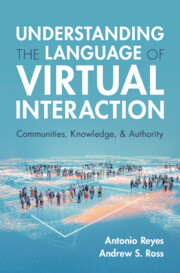
-
Select format
-
- Publisher:
- Cambridge University Press
- Publication date:
- 05 September 2025
- 25 September 2025
- ISBN:
- 9781009328678
- 9781009328661
- 9781009328692
- Dimensions:
- (229 x 152 mm)
- Weight & Pages:
- 0.466kg, 216 Pages
- Dimensions:
- (229 x 152 mm)
- Weight & Pages:
- 0.33kg, 216 Pages
You may already have access via personal or institutional login
Book description
Since the advent of Web 2.0, the interaction of user-generated content on participatory platforms has democratized content creation and reshaped communication, identity, authority, and knowledge across various fields, from health to politics, amid the post-truth phenomena. This timely book provides essential insights into the transformative effects of the evolving digital landscape. It gives a comprehensive analysis of how areas such as health, politics, and language ideology have been influenced by digital communication, and explores how online spaces have amplified minority voices, promoting inclusion and representation, while also addressing the backlash that challenges human rights associated with Internet use and the free exchange of information. The book also examines the intersection of law and digital crime, revealing the legal challenges posed by the online world. As our understanding of identity, knowledge, and authority increasingly intersects with Generative AI, it also discusses the impact of intelligent tools and the challenges they present.
Contents
Metrics
Altmetric attention score
Full text views
Full text views help Loading metrics...
Loading metrics...
* Views captured on Cambridge Core between #date#. This data will be updated every 24 hours.
Usage data cannot currently be displayed.
Accessibility standard: WCAG 2.2 AAA
Why this information is here
This section outlines the accessibility features of this content - including support for screen readers, full keyboard navigation and high-contrast display options. This may not be relevant for you.
Accessibility Information
The PDF of this book complies with version 2.2 of the Web Content Accessibility Guidelines (WCAG), offering more comprehensive accessibility measures for a broad range of users and attains the highest (AAA) level of WCAG compliance, optimising the user experience by meeting the most extensive accessibility guidelines.
Content Navigation
Table of contents navigation
Allows you to navigate directly to chapters, sections, or non‐text items through a linked table of contents, reducing the need for extensive scrolling.
Index navigation
Provides an interactive index, letting you go straight to where a term or subject appears in the text without manual searching.
Reading Order and Textual Equivalents
Single logical reading order
You will encounter all content (including footnotes, captions, etc.) in a clear, sequential flow, making it easier to follow with assistive tools like screen readers.
Short alternative textual descriptions
You get concise descriptions (for images, charts, or media clips), ensuring you do not miss crucial information when visual or audio elements are not accessible.
Full alternative textual descriptions
You get more than just short alt text: you have comprehensive text equivalents, transcripts, captions, or audio descriptions for substantial non‐text content, which is especially helpful for complex visuals or multimedia.
Visual Accessibility
Use of colour is not sole means of conveying information
You will still understand key ideas or prompts without relying solely on colour, which is especially helpful if you have colour vision deficiencies.
Use of high contrast between text and background colour
You benefit from high‐contrast text, which improves legibility if you have low vision or if you are reading in less‐than‐ideal lighting conditions.

